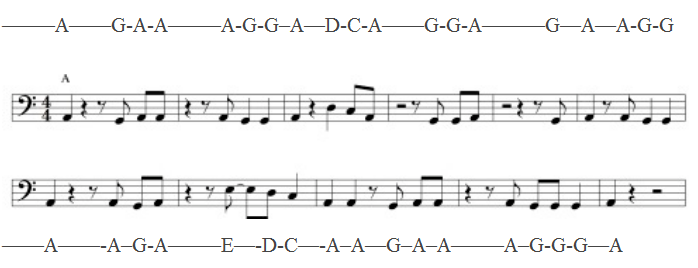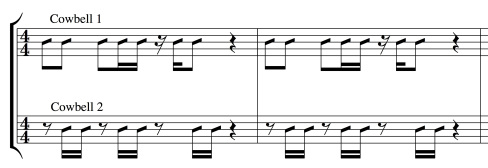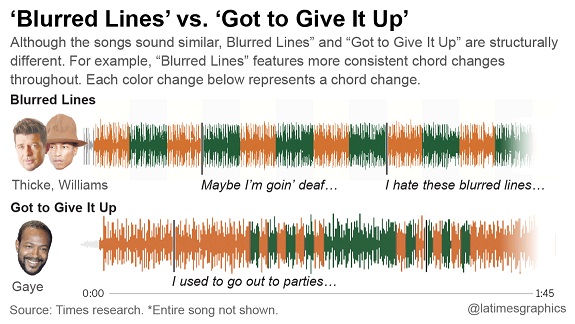The verdict in the “Blurred Lines” case surprised a lot of people, myself included. I incorrectly predicted that the Pharrell Williams-Robin Thicke camp would prevail, 1 and certainly did not foresee the millions of dollars in damages that were assessed by the jury. As a general rule, having served on a jury myself, I do not criticize jury verdicts. The jury hears all the evidence, not just what is reported in the news media. But here, where the two works are readily available for examination, and having a background in music as well as law, I will have to break my rule and say I disagree with the jury’s verdict.
It turns out that I was not alone in my thinking. Indeed, after the verdict, many musicians and composers lit up the internet with posts about how wrong the verdict was. I was unable to find a side by side comparison of the melodies in musical notation. To my ear, though, the melodies are not all that similar. The lyrics are completely different, but that is not unusual. Most cases of music infringement come down to the notes sung, not the lyrics. This was the case in the George Harrison “My Sweet Lord” case, the Bee Gees “How Deep Is Your Love” case and the recent settlement between Sam Smith and Tom Petty, over “Stay With Me.” 2 In all three cases, the lyrics were completely different. More about the latter two further on.
With regard to “Got To Give It Up” (GTGIU), I did find this very thorough and well-reasoned analysis by musicologist Joe Bennet. 3 One of the claimed similarities was the bass line. Here is a comparison of the two bass lines. The bass line from “Blurred Lines” (BL) was transposed from G major into the key of A minor, and GTGIU was transposed from A major to A minor. This was done so that any similarities should be fairly obvious and avoiding needing a key signature. 4 These are Mr. Bennet’s work for which I give him full credit and my sincere appreciation. Sometimes a visual reference can make complicated issues clearer.
This is the bass line from “Got to Give It Up.” For those of you who do not read music I have notated it for you.

This is the bass line for “Blurred Lines.”

I just don’t hear it, and I certainly don’t see it. The GTGIU bass line runs for 11 bars, while the BL repeats on an eight bar cycle. The BL bass line is far more sparse and repetitious, and the octave jumping flourish at the end has been a staple of funk/disco music for at least 40 years, maybe more.
Then there is the chord progression, or lack thereof. BL is basically what musicians call a “vamp,” a cycle of repeated chords that does not change. This chart comes courtesy of the LA Times newspaper, 5 and shows that the phrasing of the chords is very dissimilar.
Music theory graduate Dan Bogosian put it like this:
“There are literally only two chords in “Blurred Lines;” a lot of people have inappropriately labeled it G to D, but it’s actually C/G to D. That’s one of the gratifying things about the song: because the C chord doesn’t have a C in the bass, it maintains tension throughout… the genius of Williams and Thicke has the bass doing one thing, and everything else doing another.” 6
“This progression is known as IV to V, and it’s one of the most common set of harmonies in all of music; it happens in every single doo-wop song, and in roughly half of all pop songs and classical compositions. A bass line that never hits the root or truly resolves is unusual nowadays, but it’s actually the defining trait that makes the opening moment of “Blurred Lines” funky.” 7
“On the other hand, “Got to Give it Up” has twice as many chords as Thicke’s (four versus two), and includes the IV to V chord progression on every repeat. Each repeat resolves, never using the strange tension in the bass the way “Blurred Lines” does.” 8
Another allegation is that Gaye’s “distinctive cow bell” rhythm was borrowed. 9 Back to musicologist Joe Bennet, who prepared these charts:
Here is the cowbell part from GTGIU:

Bennet says there are actually two cowbell parts in BL. He transcribes them as follows: 10

The only similarities are the first two notes, and the first eighth note of the second bar. Everything else is different.
Back to Dan Bogosian:
“Got To Give It Up” opens with a melodic run that spans the same musical distance as the entire Thicke song. It’s actually a perfect vehicle to show off Gaye’s voice; the run is challenging by itself, and he routinely jumps up and down four scale notes — no easy feat for an untrained vocalist. “Blurred Lines” is the opposite: the reason everyone seems to be able to sing along with Thicke…[is] that they’re sung entirely within the first five notes of the major scale (i.e. the pentascale).” 11
“To put it in more digestible terms: Thicke’s vocal performance is comparable to Ringo Starr’s in “Yellow Submarine,” and Marvin Gaye was one of soul music’s greatest talents because of vocal parts like “Got To Give It Up.” 12
“Throwing aside that Marvin Gaye’s song is nearly three times as long as “Blurred Lines,” it’s still obvious that the melodies, harmonies, chord progressions, and rhythms are different.” 13
Remember the test for infringement is “substantial similarity” not just similarity. What does substantial similarity look and sound like? Here is a very recent example; Tom Petty and the Heartbreaker’s “I Won’t Back Down” and Sam Smith’s “Stay With Me” (which, by the way, won a Grammy as Song of the Year, 14 an award given to the songwriter. Oops). After adjusting for pitch and tempo, this mash-up shows that the two songs can be sung right over each other, and the choruses are nearly identical.
Here is a transcription of the two competing songs in the “How Deep Is Your Love” case. (I have forgotten where I got this, so if this is your work, please contact me so I can give proper credit.)

Look at the first three bars of music. Out of the eight notes played, six are the exact same pitch, and the timing of all the notes is identical. All counted, there are 30 instances of notes sharing the same pitch and time value. It is worth mentioning that this jury also ruled against the Bee Gees, a finding later reversed for lack of proof of access by the Bee Gees.
In the GTGIU case, both sides presented dueling expert witnesses as to the infringement or non-infringement of GTGIU. Judith Finell was the expert for the Gaye estate.
“She found the similarities in their melodies ‘pretty stunning’ and ‘highly unusual,’ she testified. She said both begin with a repetition of the same note — ‘one of the most important considerations in comparing melodies’ — and end with a single word (‘girl’ and ‘dancing’) sung over several notes, the effect called a melisma, among other likenesses.” 15
The fact that both songs repeat the first note is “’one of the most important considerations in comparing melodies’? Perhaps, but musically it’s also one of the easiest things to do. Most of her remaining testimony regaled the jury with points which are in my mind, so picky as to be almost irrelevant, such as:
“’In the case of these two hooks, the key words of the hook, the money words — ‘good girl’ and ‘dancing’ — come immediately after the bar line,’ said Finell, referring to the timing of the words.” 16
Really? This is evidence of substantial similarity? I’m not buying it.
“The phrases share three of their four notes, she said.” 17 Well, now you’ve got something, but you have to examine the rest of the song as well, not just four notes. It’s substantial similarity, not just similarity.
So where did the Williams/Thicke camp go wrong? I think that Robin Thicke was hamstrung by his own press interviews in which he admitted that GTGIU was the template for writing BL. 18 His attempts to backtrack from these statements at trial obviously made it worse and set the jury on a course against him. As I have noted before on this blog, juries take a very dim view of perjury, and they tend to slam the perceived perjurer accordingly.
So where does the Williams/Thicke team go from here? Well, naturally, their lawyer has announced the inevitable appeal 19 as well as a flurry of post-trial motions. 20 The first is likely to ask the Judge for a “Judgment Notwithstanding the Verdict,” or Judgment N.O.V. Basically, this motion asks the Judge to rule for their side, and toss out the juries’ verdict. There, they will argue:
• “On the merits, there was no properly‑admissible evidence upon which the jury could have found copying. A comparison of the two songs readily reveals that there isn’t one note in the melody that’s the same, there isn’t one chord in the entire song that’s the same, and there are no more than three notes in the bass lines, out of twenty six notes, that are the same.” 21
• “While the judge correctly ruled that only the sheet music deposited with the copyright office was at issue, the Gaye’s musicologist improperly testified as to several alleged similarities between the two songs that are not reflected in that sheet music.” 22
• The Gaye family “musicologist testified that the lyrics were significantly similar, even though there aren’t two words in common.” 23
• [T]he jury was not permitted to learn that the Gayes consulted with at least two prominent musicologists who declined to give an opinion that the songs were substantially similar before finding musicologist Judith Finell to provide the opinion they needed. 24
This is a tough one to win. Basically, you’re going to have to convince the Judge that he should not have admitted evidence that he already deemed admissible, and that no jury in their right mind could find a case of infringement, when this jury did just that.
Then there’s the appeal. Along with the points raised above, the jury’s answers to questions in the verdict also might be mined for appellate fodder. The jury found responsibility for the infringement on William and Thicke, but no one else. So far so good. When asked the question, was the infringement of Williams and Thicke “innocent,” they answered “no.” So the infringement was willful then, right? Again, the jury says “no.” So if the infringement was not innocent, and not willful, then what was it? Accidental? The Williams/Thicke side has all admitted they knew the song well and were attempting to emulate its “vibe.” A very curious verdict indeed.
As to what this all means for the future of music? Not much, really. Jury verdicts have very little precedential value, and findings of infringement tend to be rare and fact specific. Consider that performing rights society ASCAP claims to represent 525,000 composers, 25 and while I was unable to get a fix on the number of songs administered by ASCAP, the last figure I read put it around 7 million songs. Notable successful copyright infringement claims number but a handful. This is because most copyright claims fail on the question of access, that is, the composer had to have heard the song in order to copy it. This is why the Bee Gees ultimately prevailed, despite the very similar nature of the songs in question. It also proves that two songs can be composed in isolation of each other, and yet be substantially similar.
This is not the case with “My Sweet Lord,” “Stay With Me” and “Blurred Lines.” In each case, the complaining party had a hit song that makes access a foregone conclusion, or at least very hard to deny. 26
Two final notes. Attorneys for the Gaye estate say they will seek an injunction against further distribution of BL. 27 This does not make sense. Why stop distribution of the most popular song of last year? It would be better to file a motion to require the record companies pay all the subsequent royalties over to the Estate, one would think.
Also, the attorney for Williams and Thicke is quick to say “[L]et me disabuse the world of the notion that our clients started this confrontation. A declaratory relief lawsuit was filed by our clients only after the Gaye family threatened to bring their own copyright infringement claim when discussions broke down in the face of the Gaye’s demand that they be given 100% ownership of ‘Blurred Lines.’” 28 Well, except that you did file the suit first, bringing the dispute to a head. Yes, because of the Supreme Court ruling in the Raging Bull case, the three year statute of limitations would never run out, 29 but if the Gaye Estate waited long enough, they would only be able to claim damages for the three year period immediately preceding the filing, and therefore possibly limit the amount of damages they could request.
Right now, it’s winner take all. And if I were Robin Thicke’s attorney, I’d tell him to shut up.
Notes:
- The Fight over “Blurred Lines:” What Parts of a Song are Copyrightable? ↩
- Tom Petty on Sam Smith Settlement: ‘No Hard Feelings. These Things Happen’ ↩
- Did Robin Thicke steal ‘Blurred Lines’ from Marvin Gaye? ↩
- Id. ↩
- ‘Blurred Lines’ vs. ‘Got to Give It Up’ ↩
- A Music Theory Expert Explains Why the “Blurred Lines” Copyright Decision Is Wrong ↩
- Id. ↩
- Id. ↩
- Did Robin Thicke steal ‘Blurred Lines’ from Marvin Gaye? ↩
- Id. ↩
- A Music Theory Expert Explains Why the “Blurred Lines” Copyright Decision Is Wrong ↩
- Id. ↩
- Id. ↩
- Stay with Me (Sam Smith song) ↩
- How Similar Is ‘Blurred Lines’ To A 1977 Marvin Gaye Hit? ↩
- Id. ↩
- Id. ↩
- Marvin Gaye’s heirs win $7.4 million for ‘Blurred Lines’ plagiarism ↩
- Robin Thicke and Pharrell’s Lawyer to Appeal ‘Blurred Lines’ Verdict ↩
- Pharrell Williams’ Lawyer: “We’re Entering the Bottom of the Sixth Inning” (Guest Column) ↩
- Id. ↩
- Id. ↩
- Id. ↩
- Id. ↩
- About ASCAP ↩
- Tom Petty on Sam Smith Settlement: ‘No Hard Feelings. These Things Happen’ ↩
- Living in Blurred Times ↩
- Pharrell Williams’ Lawyer: “We’re Entering the Bottom of the Sixth Inning” (Guest Column) ↩
- Taking the Raging Bull by the Horns: A Statute of Limitations That Never Expires? ↩
